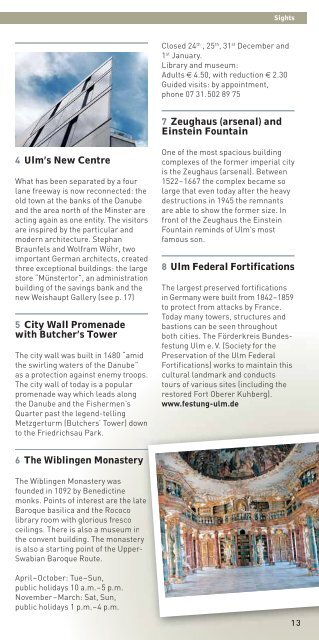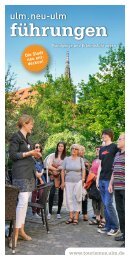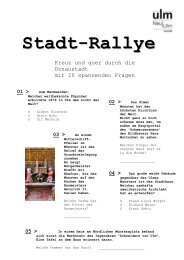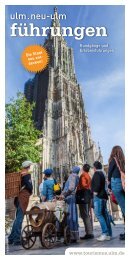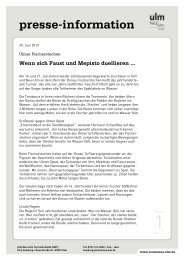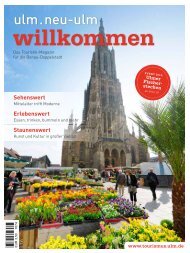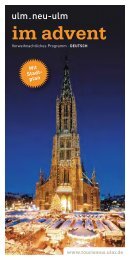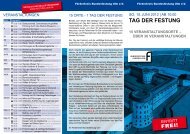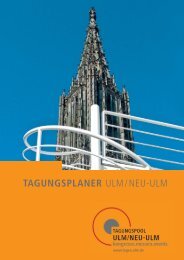Informative City-Guide · ENGLISH - Ulm/Neu-Ulm
Informative City-Guide · ENGLISH - Ulm/Neu-Ulm
Informative City-Guide · ENGLISH - Ulm/Neu-Ulm
You also want an ePaper? Increase the reach of your titles
YUMPU automatically turns print PDFs into web optimized ePapers that Google loves.
4 <strong>Ulm</strong>’s New Centre<br />
What has been separated by a four<br />
lane freeway is now reconnected: the<br />
old town at the banks of the Danube<br />
and the area north of the Minster are<br />
acting again as one entity. The visitors<br />
are inspired by the particular and<br />
modern architecture. Stephan<br />
Braunfels and Wolfram Wöhr, two<br />
important German architects, created<br />
three exceptional buildings: the large<br />
store “Münstertor”, an administration<br />
building of the savings bank and the<br />
new Weishaupt Gallery (see p. 17)<br />
5 <strong>City</strong> Wall Promenade<br />
with Butcher’s Tower<br />
The city wall was built in 1480 “amid<br />
the swirling waters of the Danube”<br />
as a protection against enemy troops.<br />
The city wall of today is a popular<br />
promenade way which leads along<br />
the Danube and the Fishermen’s<br />
Quarter past the legend-telling<br />
Metzgerturm (Butchers’ Tower) down wn<br />
to the Friedrichsau Park.<br />
6 The Wiblingen Monastery y<br />
The Wiblingen Monastery was<br />
founded in 1092 by Benedictine<br />
monks. Points of interest are the late te<br />
Baroque basilica and the Rococo<br />
library room with glorious fresco<br />
ceilings. There is also a museum in<br />
the convent building. The monastery ry<br />
is also a starting point of the Upper- r-<br />
Swabian Baroque Route.<br />
April – October: Tue – Sun,<br />
public holidays 10 a.m. – 5 p.m.<br />
November – March: Sat, Sun,<br />
public holidays 1 p.m. – 4 p.m.<br />
Sights<br />
Closed 24 th , 25 th , 31 st December and<br />
1 st January.<br />
Library and museum:<br />
Adults € 4.50, with reduction € 2.30<br />
<strong>Guide</strong>d visits: by appointment,<br />
phone 07 31 . 502 89 75<br />
7 Zeughaus (arsenal) and<br />
Einstein Fountain<br />
One of the most spacious building<br />
complexes of the former imperial city<br />
is the Zeughaus (arsenal). Between<br />
1522 – 1667 the complex became so<br />
large that even today after the heavy<br />
destructions in 1945 the remnants<br />
are able to show the former size. In<br />
front of the Zeughaus the Einstein<br />
Fountain reminds of <strong>Ulm</strong>’s most<br />
famous son.<br />
8 <strong>Ulm</strong> Federal Fortifications<br />
The largest preserved fortifications<br />
in Germany were built from 1842 – 1859<br />
to protect from attacks by France.<br />
Today many towers, structures and<br />
bastions can be seen throughout<br />
both cities. The Förderkreis Bundesfestung<br />
<strong>Ulm</strong> e. V. (Society for the<br />
Preservation of the <strong>Ulm</strong> Federal<br />
Fortifications) works to maintain this<br />
cultural landmark and conducts<br />
tours of various sites (including the<br />
restored Fort Oberer Kuhberg).<br />
www.festung-ulm.de<br />
13


